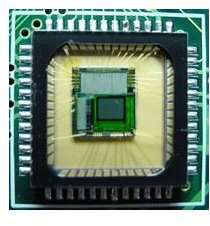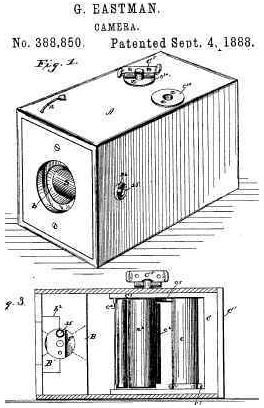Learn How a Camera Works - Beginner Photography
Digital Camera Picture-Taking “Magic”
Cameras have truly come a long way since the September 4, 1888 Kodak patent by inventor George Eastman. You take out your digital camera, turn it on, frame and compose your subject watching a display screen on the back or side of your camera, then press and hold the shutter button for about a second. This allows your digital camera to focus on the subject then automatically set the proper exposure to capture the image. You hear the familiar “beep! beep!” and your “finished” picture appears in the camera display window.
If we consider some of our last decade’s most important inventions and developments such as CDs, DVDs, HDTV, MP3s and DVRs, these are all developed around a single, basic process, that is the converting of analog data (fluctuating wave) into digital (stored as ones and zeros) or data bits. Digital cameras use data bits stored electronically, while conventional cameras use a mechanical and chemical-based process of light-sensitive emulsion on celluloid film to capture images. But what happens exactly, between the time you press the shutter button and the final display of the captured image? Let’s briefly examine just that.
Taking a Digital Photograph, Say Cheese!
As a quick overview, what happens when you press the shutter button is as approximately follows, depending on the make and model of the digital camera you have:
1. The auto-focus system measures the distance to the subject, projecting a guide light
2. Small circuit board-controlled motors move the lens in and out (zoom) to focus on the subject
3. The amount and kind of light entering the lens is measured, white balance is set
4. The aperture opening or f-stop is set
5. The shutter speed is set to correspond to the f-stop and ISO setting
6. The electronic shutter opens and closes at the speed set by the camera’s central processor
7. The digital image is recorded by a digital sensor array
8. The image is recorded to a storage device
9. The stored image is displayed on an LCD viewing screen
10. The camera battery or power system capacitors recharge (this is when the screen goes blank)
11. Fully recharged, the camera displays the current image on the LCD viewing screen
12. The camera is again “re-set” to a neutral mode, ready for the next operation
Now we can briefly discuss some of these elements in a bit more detail.
Taking a Digital Photograph

After depressing the shutter button on a digital camera, the light entering the diaphragm hits a digital sensor array. In a film camera this is where the film frame is located. Digital camera arrays are approximately thirty-five times more sensitive to light than a film camera, making digital cameras ever more popular with both photographers and astrophysicists. The digital sensor array consists of “chips” called a Charge-Coupled Device (CCD). CCD is the type of image sensor used in most digital cameras. Other digital camera models use a Complementary-Metal-Oxide-Semiconductor or CMOS (pictured - click to enlarge). A few other cameras use a Foveon, or other types of digital sensor arrays depending on the digital camera’s make and model. Each type of digital sensor in turn, is a collection of millions of sensor points which are called <em>pixels</em>, an abbreviation for “picture elements.” Pixels then, are arranged in a series of rows and columns much like a checker board. As an example, if a camera has a sensor array that is 3008 pixels horizontal, and 2000 pixels vertical, that is 3008 times 2000 which equals 6,016,000. This number means that the camera would have over six million pixels in its digital sensor array, or would be categorized as a 6 megapixel camera by manufacturers. You can look up the pixel dimensions of your camera’s digital sensor array and its sensor array type in the manual which comes with the camera.
Digital Camera Lens Focus
The camera lens focal length determines how much of an image appears whenever you look through a camera viewfinder or at the camera’s digital image viewing screen. Many 35mm film cameras use a 50mm lens for the most original digital image of whatever you’re photographing. By increasing the camera lens focal length you can increase the magnification or in effect, cause subjects to appear to be much closer. Decreasing the camera lens focal length has the exact opposite effect of causing subjects to appear to be more distant. When a lens can adjust its focal length it is commonly referred to as a zoom lens. A number of digital cameras have both optical and digital zoom features. If your camera has macro focusing features for shooting extreme close-ups, you can take images from as close as a few millimeters in front of the camera lens.
Almost all lower-price range digital cameras or “point-and-shoot” cameras are completely automatic in focus and settings. In these types of cameras, the central processor uses small, circuit board-controlled motors to move the camera lens in or out to focus on the subject based on feedback from an optical distance measuring system. The digital camera’s central microprocessor also receives information from the camera’s auto-focusing system and the camera’s light meter. Other small circuit board-controlled motors then open and close the digital camera’s light aperture (or f-stop). These factors in combination, aperture f-stop, shutter speed, focus and effective focal length or zoom, create the exposure to produce a digital image. Depending on your digital camera price range, production year, make and model, it will come equipped with one of the following four types of lenses.
The Four Lens Types of Digital Cameras:
1. Fixed-focus, fixed-zoom lenses - These types of lenses are found on disposable and low-end price range cameras (both digital and film).
2. Optical-zoom lenses with automatic or manual focus – These types of lenses have two or three focus “setting ranges” such as close-up, portrait and landscape which allow the taking of photographs of flowers at one focus setting, peoples faces and torsos at a second focus setting, and the photography of scenes and views like landscapes at this focus setting.
3. Digital zoom - Using digital zoom, the camera records pixel information from the image sensor’s center and extrapolates that information to create a complete digital image. When the camera image sensor resolution is high, the digital image produced appears sharp. A very blurred, grainy or hazy image results when the camera image sensor resolution is low. A similar process would occur if you cut the central part out of a digital image and then enlarged that small portion of the image using photo editing software.
4. Interchangeable lenses - As with higher-end SLR film cameras, you can remove and change the lenses of a digital camera designed in this manner. These are called DSLR or digital single lens reflex cameras. The camera is capable of using a series of different focal length or zoom lenses.
There you have it. Now you should have a much better idea of how a digital camera works. But to help yourself understand each of these digital photography imaging-related factors, why not look into some tutorials to make advanced photography simple?
References:
1. How Digital Cameras Work
https://www.howstuffworks.com/digital-camera.html
2. How Does a Digital Camera Work?
https://www.wisegeek.com/how-does-a-digital-camera-work.htm
3. Guides Nikonians: HOW IS THE IMAGE STORED?
https://www.nikonians.org/html/resources/guides/digital/how_does_it_work_1.html
